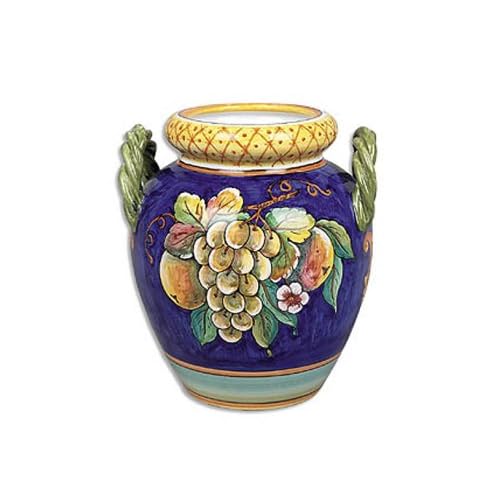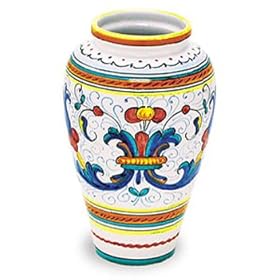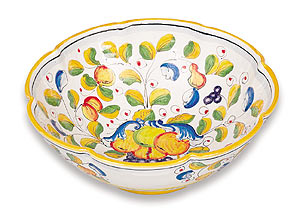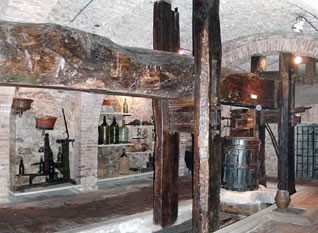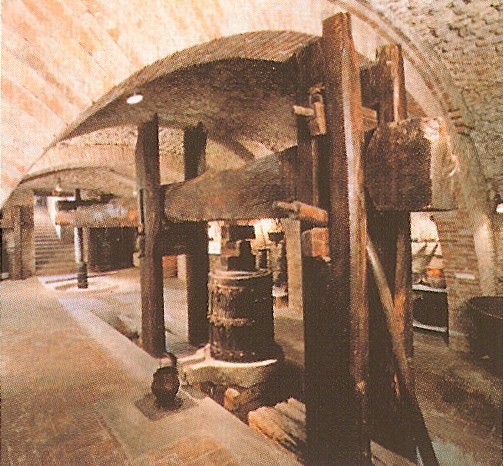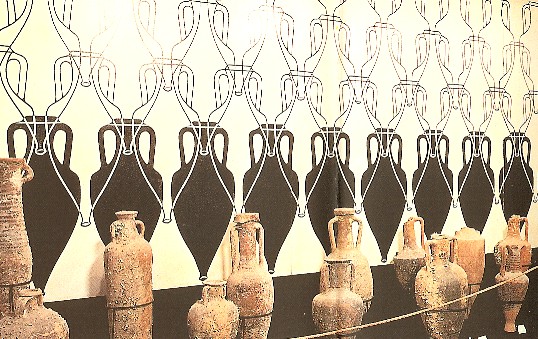We rode across the valley to our first stop, Sberna Ceramics (Ceramiche Sberna) in Deruta. After receiving a warm greeting from Anna, the daughter of the owner, we went directly to the basement of the shop where we watched Roberto, a highly skilled craftsman, take no time at all to throw a pitcher and a plate on the wheel. He began with a moment of meditation, then plopped one of those three bpictured blobs onto the wheel. He soon hollowed that out and began squeezing the walls upward. He continued raising the sides by using his fingers to thin and shape them. Finally he formed a lip, then stopped the wheel and pinched the lip form a spout. Once we finished ooohing and ahhhing, Roberto then sliced his new pitcher in half (ouch!) to show us its walls, after which he quickly formed a dinner plate.
These are the handmade products. We also saw a man using a mechanical press of some sort to stamp out plates for mass market customers such as Starbucks, Williams-Sonoma and Pier 1. Next, after drying for five days, the pieces were dipped into glaze by a man named Francesco. After glazing, the pieces are fired, then hand painted, then fired again. This was definitely handwork, not the "industry on parade" machinery we think of when we think "production". There's a description of the glazing/decorating process here.
We were fortunate enough to find Francesco Sberna himself, the founder of the business, at work painting tiles. His signature on the bottom of a piece puts it well outside of most people's range. He's a man in his eighties who looks, as Marco said, like someone from Dante's second circle of Hell: short, fat, devilish, always looking for something or someone to make a joke about.
Upstairs, we had a chance to shop from an enormous selection of gorgeous things. Were helped by Francesco's daughter Anna and Mrs. Sberna as well. We also met the family cat, Ringo, who is the darling of the family and of most visitors.
We bought a cream and sugar set with tray in a traditional Deruta pattern and a small serving plate in a peacock tail motif. What we left behind was a sensory overload of beautiful pottery:
The museum was the idea of Countess Lungarotti, who not only runs a thriving winery but also an agriturism complex. She and her late husband, Count Giorgio Lungarotti, created the museum and opened it in 1974. Today the museum is operated by the Lungarotti Foundation. It is located on the first floor and basement of the Palazzo Graziani-Baglioni, a 17th century noble summer residence.
The museum is a fascinating combination of a history lesson along with the story of the development from ancient times of the making and drinking of wine, illustrating not only the evolution of the equipment for making wine but also the vessels used for storing, transporting, and drinking wine. There are also many art works, drawings, paintings, prints, and ceramics illustrating the consumption of wine.
Featured in the basement is a huge wooden wine press. The beam is 12 meters (about 40 feet) long, all of one solid piece of oak. At the other end from the grape barrel is a huge wooden screw, turned by either animals or men, applying immense leverage to the press in the barrel. I also learned something from the display (seen above): those amphorae with the pointed bottoms? They were plunged into sand in a ship's hold. Then subsequent layers of jugs were inserted into the mouths of those below. I was also pleased to be able to answer our guide's question about what the little plate with two handles was used for Kottabos, a game played in the Andron (I learned about that long ago, in San Francisco's now-defunct Wine Museum).
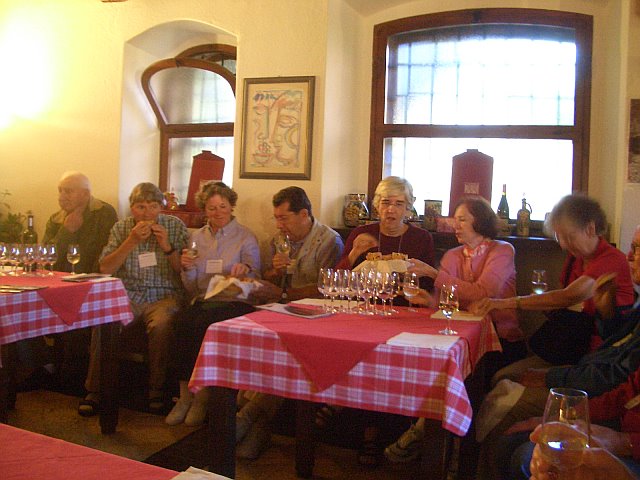
|
On the way back to Assisi we stopped so the shutterbugs could take all they wanted of the panoramic view of the town. I took some but gave up when I realized that a large yellow crane was dominant in nearly ever angle I could get to. My experience with shots like this is that it's better left to professionals: they can choose the vantage point, time of day, weather (overcast sky usually works best for me, e.g.), amount of tourists (usually none on a cold clear winter morning), etc. For my own activity, I much prefer snapshots with folks I know in their exotic or historical setting.
Back-to-back Double Lectures (ugh) -- Etruscans and Rural Umbrian Life
During the afternoon, after a fairly exhausting morning, we were treated to two double-length lectures, each of which would have been excellent on its own but, packed together in one long postprandial orgy of lecturing, were simply too much of a muchness. Such thoughtless scheduling was one the major criticisms I raised in the final evaluation of the program.

|

|
Louise gave an historical overview, beginning with 900 BC Iron Age origins. East of the Tiber, they had agricultural surpluses and iron to trade with others. They also had coastal cities, mined iron ore at Volterra, along with copper and gold. With leisure, they became the first Mediterranean portrait artists. Their priests took a strong interest in studying the weather and bird flights. The Etruscans were the first people in Italy to practice dentistry. They used wool cloth mostly and had to import linen. They did extensive trade with the Greeks and were much influenced by them; their temples were built on the Greek model ... column, steps, tiled roofs with sculptures. Moreso than the Greeks, their women could own land, were educated and could write. They loved shoes. I noted a strong similarity between their art and that of the Minoans who perished when Thera blew up in 1400 BC. The richest period of Etruscan culture was 650-300 BC. During the Hellenistic era things began going downhill and the Etruscans were gradually absorbed by the Romans. Fascinating people.
 |

|
Anne Robichaud received her degrees in both English Literature and Italian Language and Literature from the University San Clara (CA). She has made her home in Italy, just outside Assisi, since 1973. Her presentation was a lively, more-or-less personal memoir of her experience with rural life, essential for understanding the outlook of Umbrians. She has a website, and she has written on the 'net briefly about the subject of her talk to us, "On the Land in Umbria". The photo, from this site, shows Anne and her Italian husband Pino.
Dinner at Taverna Dei Consoli -- molto delizioso!

|

|

|

|


























